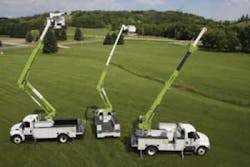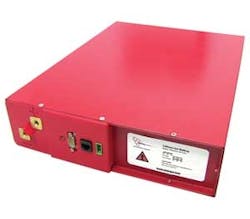From the July, 2012 Issue of Cabling Installation & Maintenance Magazine
An innovative battery system can be a solution to the competing requirements of higher fuel economy and the need to power work devices.
By Joe Marshall and Jon Promersberger, Terex; Stanley Mlyniec and Michael Kulesky, EnerSys
Telecom installers and repairers face a bevy of challenges every day—working long, irregular hours, driving utility vehicles great distances to and from numerous job sites, and scaling 40-foot poles in all kinds of weather. Regulations and fiscal pressures further complicate the job. Work crews also must be mindful of today's increasingly stringent environmental regulations that limit vehicle weight and govern fuel efficiency, noise and idling time.
However, work trucks with new hybrid charging systems are providing telecommunications companies with tremendous job site freedom and flexibility. Supported by lightweight lithium ion batteries, new hybrid trucks are helping to meet today's regulations on weight restrictions, emissions and idling while enabling work crews to operate outriggers, booms, lights and more—without even having to start the truck's engine.
From tree limbs to telecom
Originally known as a "cherry picker" in the early 1900s, the bucket truck has evolved from a simple bucket on a boom designed to help orchard workers reach high tree limbs to today's sophisticated, multipurpose vehicle for telecommunications, utilities and more. For the brave workers who ride the bucket, safety has always been a prime concern. Safety enhancements over the years have resulted in insulated buckets, redundant braking systems, multiple harness points and stabilizing outriggers with audible and visible alarms.
Today's trucks also offer workers tremendous flexibility. Their booms and buckets can be positioned in various locations on the truck and are precision-controlled to enable workers on the ground and on the platform to adjust height, angle and movement for maximum efficiency on the job. Power steering, advanced handling systems and creature comforts, such as heat, air conditioning and radios, are now standard features on our everyday work trucks.
Green engineering
The dawn of the green movement in the 1980s saw a major shift in the evolution of truck manufacturing toward green engineering. This movement has continued to gain momentum, propelled by increasingly strict regulations governing both manufacturers and operators of today's work trucks.
Gross vehicle weight ratings (GVWR). Set and specified by the vehicle manufacturer, the Gross Vehicle Weight Rating is the maximum allowable total weight of a vehicle when loaded, including passengers and cargo. The U.S. Environmental Protection Agency (EPA) and Department of Transportation's National Highway Traffic Safety Administration (NHTSA) classify trucks in eight gross-vehicle-weight (GVW) classes. There are transportation and cost implications to exceeding established GVWR. As a result, today's bucket trucks are being built for greater efficiency and feature narrower profiles, lighter-weight materials and smaller footprints.
Fuel economy. In August 2011, the EPA and NHTSA announced a first-ever program to reduce greenhouse gas (GHG) emissions and improve fuel efficiency of buses and heavy-duty trucks, including vocational work trucks, which are the second-largest contributor of oil consumption and GHG emissions in the transportation sector. The agencies estimate that the new standards will reduce carbon dioxide (CO2) emissions by about 270 million metric tons and save 530 million barrels of oil over the life of vehicles built for the 2014 to 2018 model years. Under the new program, vocational trucks will be required to reduce fuel consumption and greenhouse gas emissions by approximately 10 percent by model year 2018. These trucks could save an average of one gallon of fuel for every 100 miles traveled, providing vehicle owners $50 billion in fuel savings over the lifetimes of these vehicles. Overall the program is expected to yield an estimated $49 billion in societal benefits. The majority of vehicles will see a payback period in less than one year. (Source: EPA Regulatory Announcement, Office of Transportation and Air Quality, EPA-420-F-11-031 and -032, August 2011.)
Truck idling laws. Conventional utility trucks use the chassis engine to power the boom/bucket/AWP by way of a power take off and hydraulic pump. Typically these systems require the engine to run at idle, while the operator is working with the boom in the air. The chassis engine provides about 80 horsepower while idling, yet the boom only requires about 20 percent of that power, making it an inefficient use of the diesel-powered engine.
According to a study done by the Argonne National Laboratory, the total fuel use by idling trucks is estimated to be more than two billion gallons per year. The type of idling done by vocational trucks during the workday—referred to as power take off use—often is not measured by studies such as this, as useful work is being done while the engine is idling. (Source: "Estimation of Fuel Use by Idling Commercial Trucks," authored by Linda Gaines, Anant Vyas, John L. Anderson of the Center for Transportation Research, Argonne National Laboratory.)
However, a study by Advanced Energy, a nonprofit organization that helps companies achieve energy goals through consulting, testing and training services, showed that vocational trucks idle for approximately three hours per day. Assuming that each truck operates 250 days per year, this results in 750 hours of idle time per year, per truck. (Source: "Progress Energy Bucket Truck Monitoring," June 2009, Advanced Energy.)
Meanwhile, Terex Corporation, based on surveys of its customers, estimates that the average utility truck consumes 4.8 gallons of fuel per day during this idle time. This means that, in just one year, utility trucks use more than 1,000 gallons of fuel per truck—while sitting still. Terex estimates that this wasted fuel translates to more than 10 metric tons of CO2 per truck per year. (Source: www.terexhypower.com/environmentally-concerned/.)
Given these statistics, it is no surprise that 30 states have some sort of anti-idling regulations to reduce air and noise pollution. These specify the duration that a truck can idle (typically 3 to 15 minutes), the conditions under which trucks may idle (i.e., power take-off work, passenger comfort), the exceptions (i.e., traffic conditions, mechanical difficulties), and the fines (up to thousands of dollars) for exceeding these restrictions. The American Transportation Research Institute publishes an annual Compendium of Idling Regulations, which is downloadable as a handy cab card at http://atri-online.org.
Cutting noise, costs, emissions
In response to the demand for more-efficient vehicles, truck manufacturers have developed auxiliary stored energy systems that allow for boom/bucket operation while the engine is off. The HyPower system from Terex is just one example of a system that uses additional batteries on the chassis to provide hydraulic power in order to power the bucket, boom, safety lights and flashers. The auxiliary batteries also provide power for in-cab environments and for charging battery-operated hand tools, like drills, impact wrenches, crimpers and others. The auxiliary system can be charged in as few as six to eight hours in a standard 110-volt, 20-amp outlet. If the batteries require charging during the workday, a control system starts the engine to enable a quick charge. The run time typically is limited to five minutes, but is programmable to any predetermined amount of time.
Today's hybrid power systems offer many user benefits, including less engine-idle time, reduced fuel use/less time spent refueling, reduced engine wear, elimination of job-site noise/improved communication with worker in the bucket, reduced emissions and cost-efficient retrofitting. Let's take a look at each of these benefits in more detail.
Less engine-idling time—Hybrid power systems can reduce engine-idling time by approximately 750 hours annually, according to the research noted earlier.
Reduced fuel use/less time spent refueling—Terex estimates that a hybrid truck can yield fuel savings of up to 1.2 gallons per hour compared to a conventional chassis, based on 7,000 miles per year and 1,250 job-site hours. This can add up to 1,500 gallons of fuel saved per year.
Reduced engine wear—The vehicles may be spared up to three hours per day engine-running time.
Elimination of jobsite noise/improved communication with worker in the bucket—A standard truck continuously produces 75 dB of noise 10 feet away from the truck. As a normal conversation is just 60 dB, standard trucks make communication difficult, especially between workers on the ground and in the bucket. A hybrid truck periodically emits 73 dB of noise when the pump is running, but it only runs for a minute or two at a time. The rest of the time, the system is silent except for the sound of the electronics and the hydraulic oil flowing through valves.
Reduced emissions—The primary GHGs emitted by today's diesel utility truck segment are CO2, methane and nitrous oxide. Heavy-duty trucks account for nearly 6 percent of all U.S. GHG emissions, and 20 percent of transportation GHG emissions. (Source: EPA Regulatory Announcement, Office of Transportation and Air Quality, EPA-420-F-11-031, August 2011.) These GHGs may contribute to global warming, smog and acid rain. Resultant global warming also can cause an increase in "climate-sensitive" diseases, such as malaria and dengue. (Source: World Health Organization, www.who.int/mediacentre/factsheets/fs266/en/.) A hybrid system can help the atmosphere too. For example, a larger hybrid system can reduce fuel consumption by 7.5 gallons per day. This can offset up to 1,400 metric tons of CO2 every year, based on 250 working days per year. (Source: "Lean, Clean and Green," brochure from HyPower, February 2011.)
Reduced emissions also may qualify a plugin hybrid electric vehicle (PHEV) for certification by the California Air Resources Board (CARB), California's strict clean-air agency. To be certified, a vehicle must demonstrate that its exhaust and (as applicable, depending on the specific vehicle category), evaporative emission control system are durable and comply with the emission standards for the vehicle's useful life. This is done through durability and certification testing of the prototype certification vehicle(s). Compliance with on-board diagnostics, anti-tampering, fuel-tank fill-pipe and openings, crankcase emissions and other specifications as applicable, also must be demonstrated. (Source: www.arb.ca.gov/msprogr/onroad/cert/cert.php.)
Cost-efficient retrofits—An auxiliary power system can be added to an existing utility truck at a fraction of the cost of a new hybrid vehicle. In fact, a system may be designed to outlast its first vehicle so it can be reused on a new chassis. Smaller vehicles can even be outfitted with a hybrid system, as some are available that fit in the tail shelf of the vehicle body, providing maximum open bed space and easy maintenance access.
Lithium-ion batteries deliver
Installation of an auxiliary stored power system adds weight to the chassis. Given today's GVWR restriction, the user may need to give up weight capacity typically used for tools and supplies. The advancement of lithium-ion (Li-ion) battery technology, however, has allowed for overall weight reduction while improving the performance of the battery system. A Li-ion system offers up to three times the energy density of standard absorbed glass mat (AGM) lead-acid batteries and provides a longer lifecycle. This results in a system that weighs approximately 300 pounds less and lasts at least twice as long. Additionally, multiple batteries can be strung together to provide longer run time while adding little weight.
Li-ion batteries are more flexible and perform well even in partial state of charge applications, such as when a job runs overtime or requires overnight travel. For example, using quick-charging methods, a Li-ion battery will provide far more cycles than a lead-acid battery and will require fewer periodic boost charges than the lead-acid battery.
New advanced hybrid charging systems and energy-dense Lithium-ion battery technologies have the potential to facilitate telecommunications installation, maintenance and repair work by providing temporary power for short periods of time, while also meeting new requirements for fuel economy. ::
Joe Marshall is product engineer for hybrid systems, and Jon Promersberger works in new-product development for Terex Utilities (www.terex.com, www.terexhypower.com). Stanley Mylniec is an engineering manager at EnerSys Advanced Systems and Michael Kulesky is director of marketing for Enersys (www.enersys.com).

